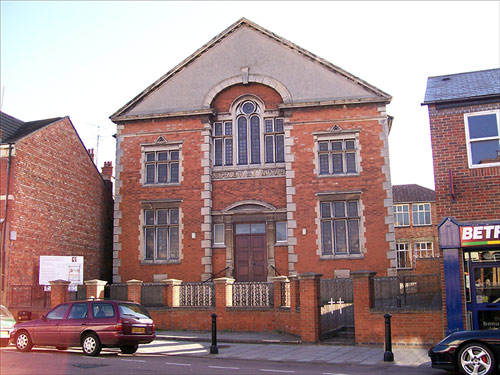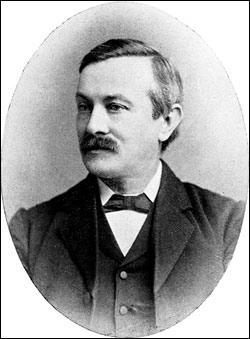|
|||||||||||||||||||
| Article extracted from "One Hundred Years of Worship" by kind permission, and compiled by Greville Watson 2007 |
|||||||||||||||||||
|
Independent Wesleyan Chapel:
History to the building |
|||||||||||||||||||
|
|
|||||||||||||||||||
|
The first Wesleyan Chapel to be built in Rushden in 1828 was near the Village Green, which was where the War Memorial is now situated. This building accommodated 40–60 people. Prior to this time the Wesleyans existed as part of the Methodist Movement but on becoming non-connexional they became independent, building their own chapel. When the congregation outgrew this they moved to Mr. Soames’ barn in Duck Street. This again became too small and in 1852 a larger hall was rented in Denton’s factory in George Street, which was from then known locally as Chapel Lane. This was at a rent of £7.10s per year. Rev. W. Griffiths, one of the ministers expelled after the break with the Methodists, opened this new meeting place and services were held here for 21 years. In 1872, a temperance hall seating 250 people was built at a cost of £200 on the site of the present chapel in the High Street. The opening service was lead by the Rev. Dr. Clifford. The minutes of the church meeting held in 1887 is the first to indicate that they hoped to build a larger church on the High Street site. Brother Claridge was charged with the purchase of 6 plots of land at a cost of 2s.6d per yard. The vendor asked for 2s.7d but the trustees felt this was too high and refused. After much haggling by both sides the trustees finally paid 3s.0d per yard! A special meeting was called to make a recommendation to the church that a special effort should be made to raise the cash. Two months later they only had £48.6s to raise. Unfortunately a committee was formed to plan how to raise the last amount and they had much discussion before reaching the decision that they could not reach a decision! However, it was at the Christmas morning meeting in 1886 that they decided that each member must pay 1d every week towards the cost of the new church and that this was a definite decision to build. The population of Rushden during this time was growing quite dramatically from 2,500 in 1873 to 12,000 in 1898. The stonelaying of the new chapel took place on September 27th 1898 in the presence of a large gathering. Many ministers, including the President of the Wesleyan Reform Union, dignitaries of the town (then described as a village), laid stones. Also stones were laid by members of church groups including representatives from the Ladies Sewing Meeting, the Sunday School, the Infants School, Adult Bible Class, the Young Ladies Sewing Class and the Band of Hope. There were thirteen tenders received from builders and the company chosen were Messrs. Dickens, the architects being Preston and Wilson. The joinery was sub-contracted to Rushden Machine Joinery Works, the plumbing to Mr. A. T. Nichols and the radiators were provided by Marriott’s. The building is of red brick and Weldon stone. The newspaper report of the day records that the convenience of the worshippers had been considered. Accommodation was provided beneath the staircases for the disposal of overcoats and umbrellas to be especially appreciated on wet days. The sides and the centre seats are raised in order that the congregation should escape draughts. The seats are of pinewood and accommodate 750 people. The new organ was built by Messrs. Martin and Coate of Oxford to the specification of Mr. J. Enos Smith, organist at the parish church. It has 2 manuals and 18 stops also incorporating a perfect tubular pneumatic action invented by Mr. John Coate. The purchase of the organ was not without problems. When the church Trustees decided to withhold payment for some period, the builders refused to deliver the organ pipes. They eventually arrived only a few days before the opening ceremony. The final payment for the organ was made a year after delivery and only after the Trustees ensured they were pleased with it. There were several gifts made to the church at this time; the architects Messrs. Preston and Wilson generously donated the pitch pine pulpit; the Young Ladies Sewing Class furnished the rostrum, the communion tables and rails; the Ladies Sewing Circle furnished the Minister’s Vestry and did all the upholstery; and members of the choir and the Bible Class undertook to furnish the choir room.
After the service a tea was held at a cost of 1s.6d [7.5p!] per couple and was provided by the Ladies Sewing Circle. 450 people sat down to eat. Tea was followed by an organ recital at 6.30pm and was played by Mr. J. E. Smith. A crowded congregation listened to a varied programme. Then came the evening meeting! Every part of the building was filled. The Rev. T. J. Harper from Wellingborough led, and was supported by the Rev. Dr. Brown from Bedford, the chapel’s own minister, the Rev. T. Bancroft with Rev. Harris and the Rev. Stephens. The chair said this was the culmination of what had been for him an “arduous yet happy ministry amongst them”. He also noted that the growth of the church was commensurate to the growth of Rushden. This brought a round of applause from the congregation. |
|||||||||||||||||||
The opening services then continued on the Sunday led by the Rev. Wright of Runcorn. The newspaper reported that there were very large congregations and that they were characterised by great heartiness, also that the choir gave several selections throughout the day with great style. During this day four collections were taken for the building fund! Following the evening service Mr. George Fairy, of the old Baptist Church, held a further organ recital. And so the new chapel of the Rushden High Street Independent Wesleyan began its work in the town.
|
|||||||||||||||||||
|
|
|||||||||||||||||||


